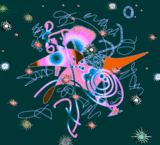By Reena Mistry

With her constant image changes, parodies of blonde bombshells such as Marilyn Monroe, her assertion of female power and sexuality, and her appropriation from gay/queer culture, the popular music icon Madonna can be seen as the virtual embodiment of Judith Butler's arguments in Gender Trouble (1990, 1999). In this postmodern feminist text, which is credited with introducing 'queer theory' to the world, Butler critiques identity-based politics as the method for female emancipation, claiming that presenting 'women' as a coherent group performs 'an unwitting regulation and reification of [binary] gender relations' (1999:9). She exposes and derationalizes the social power systems that construct the norms regarding the 'natural' gender identities of men and women, the 'logic' of heterosexuality, and the idea of a pre-discursive core gender identity, through which women are subordinated, and homosexuals, cross-dressers, and those others who are located beyond the 'imaginable domain of gender', are marginalised (ibid:13). Butler suggests that 'subversive' identities demonstrating the constructedness of sex-gender-desire continuity will work to destroy its normative status, thus allowing all 'cultural configurations of sex and gender [to] proliferate' and become intelligible (i.e. not deviant) (ibid:190). In that Madonna parodies traditional female stereotypes and adopts at her will identities that 'contradict' herself as a heterosexual female, Butler's idea of the ability for a 'variable construction of identity' (ibid:9) beyond traditional binary constructions is exposed. Further therefore, people are not restricted to (in addition to 'traditional' gender identities) the empowered female, gay and lesbian; in true queer theory style, 'one could participate in a range of identities - such as the lesbian heterosexual, a heterosexual lesbian, a male lesbian, a female gay man, or even a feminist sex-radical' (Schwichtenberg 1993:141). Indeed, Madonna has demonstrated such fluidity and ambiguity through her sexual political work - notably in the music videos for Vogue, Erotica and Justify My Love, her film Truth or Dare: In Bed With Madonna, and her book Sex.
The strong connection between Madonna and Gender Trouble is not one that has gone unnoticed; a number of writers on popular culture, queer politics and feminism have given it much consideration (see for example Kaplan 1993, Schwichtenberg 1993 and Skeggs 1993). Within such discussions - and others in 'Madonna Studies' - however, there is evidence suggestive of a limit on the extent to which Madonna can be seen to epitomise Butler's arguments. Moreover, she can be seen to contradict the aim of subversive politics, despite her public support of gay rights, her AIDS charity work and her 'flirtations' with lesbianism (Robertson 1996:119). Hence critics have started to ask: "Is Madonna a glamorized fuckdoll or the queen of parodic critique?" (ibid:118).
The ways in which Madonna can be seen to contradict the political recommendations of Gender Trouble are complex and stem from a number of critical perspectives - hence a detailed understanding of Butler's work as the next step is essential. (In part, however, the detailed description of Butler's arguments that follows is necessary also to demonstrate the extent to which Madonna embodies these arguments, which led the two to be connected in the first place. Thus, one of the aims of this essay is to determine how much Madonna contradicts Gender Trouble in relation to the extent to which she embodies it. Perhaps this will enable us to decide whether we can hold up Madonna as a political icon, a queer ambassador as it were, or whether she should be resigned to a passing (flawed) example of the variable construction of identity).
Butler opens Gender Trouble with a description of the established gender ontology in which the duality of sex (i.e. male-female) forms the basis of gender identity (masculine-feminine). This ontology carries with it the 'invocation of a nonhistorical "before"' (1999:5), hence the idea that the duality of sex, and the gendered characteristics that are said to mirror sex, are contrived is not entertained. Butler continues that the unity of sex and gender in the binary system is maintained by its oppositional nature. Society sets up 'the experience of a gendered psychic disposition or cultural identity [as] an achievement'. Hence 'one is one's gender to the extent that one is not the other gender' (ibid:29-30). Following this, the unity of sex and gender (the male's masculinity and the female's femininity) are seen to necessitate heterosexual desire - male and female desire 'therefore differentiates itself through an oppositional relation to that other gender it desires' (ibid:30). A causal relationship is established, therefore, between sex, gender and desire. As a result, anything that falls outside these gender configurations is seen as pathological, hence the marginalization of the 'assertive female,' the 'effeminate man,' the 'lipstick lesbian,' and the 'macho gay' (Sawicki 1994:301). As assertiveness, [ef]feminacy, lipstick and machismo are all allocated as various heterosexual constructs which are therefore seen to be appropriated in homosexual/queer contexts, the assertive female et al are seen merely as 'chimerical representations of originally heterosexual identities' (Butler 1999:41). Thus the original gender ontology is reified and rationalized.
for the full essay click here











0 comments:
Post a Comment